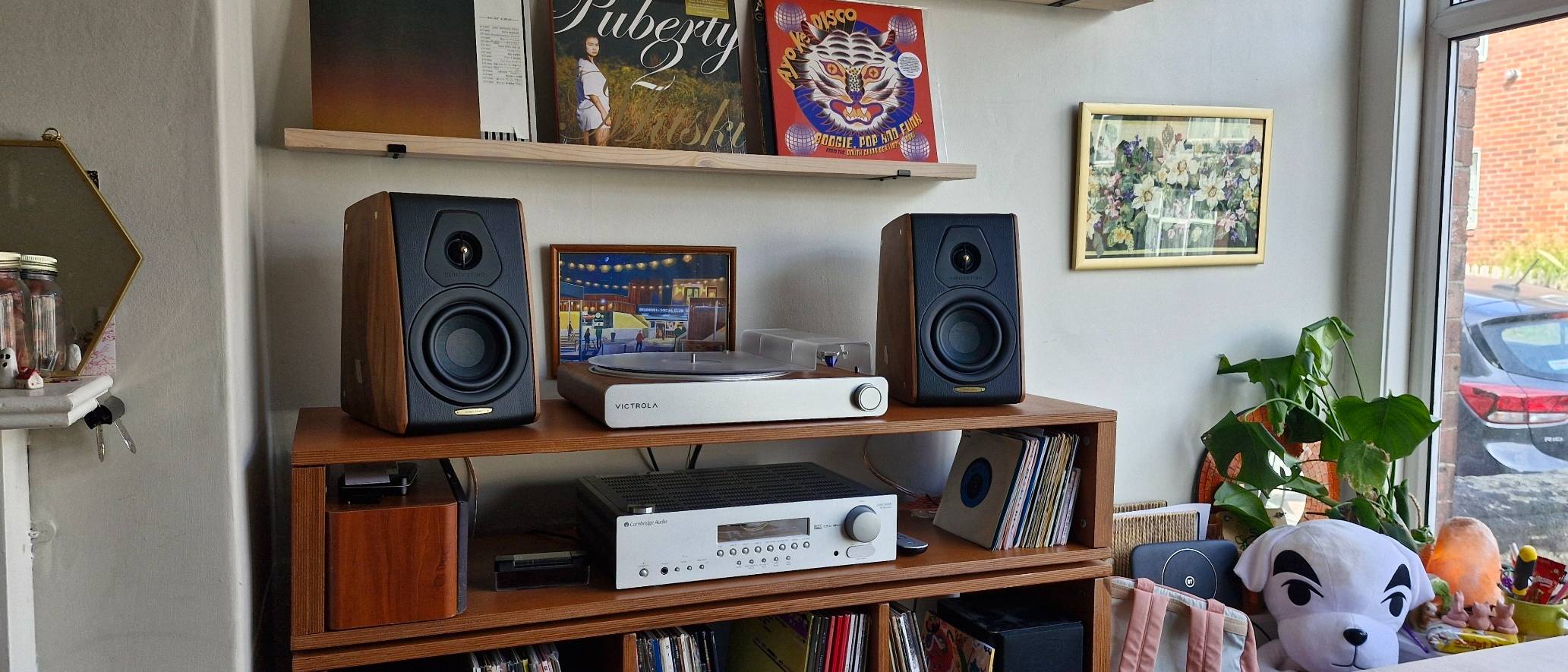TechRadar Verdict
The Sonus Faber Concertino G4 are a triumph of design, both aesthetically and sonically. From the thrilling suavity of these walnut-cheeked bookshelf speakers to the thrilling depth of their sound, this celebratory release is every bit the living-room statement it sets out to be. You’re not just buying a pair of speakers; you’re buying something built with love and intent. Plus, it’s vegan!
Pros
- +
Incredible clarity of sound
- +
Rich, three-dimensional rendering
- +
Stunning aesthetics and engineering
Cons
- -
Highly directional speakers
- -
Cloth grille covers could be nicer
- -
Justifiably expensive, but expensive nonetheless
Why you can trust TechRadar
Sonus Faber Concertino G4: Two-minute review
The Sonus Faber Concertino G4 are a very posh set of passive bookshelf speakers. That poshness isn’t just imbued by the colour palette and material choices that define their physical form, even though they do help a bit. Nor is that poshness fully explained by the not-inconsiderable $5,000 / £4,625 / AU$9,495 price point, though, again, that cost does its own fair share of heavy lifting on that front.
The poshness of these posh speakers comes, in my opinion, from Sonus Faber’s dedication to detail. So much attention has been paid to the design, construction, and resulting sound of these speakers, creating an experience arguably greater than the sum of its parts.
On the sound front, these speakers sound unsurprisingly excellent. The two-way design provides for both rich, detailed bass and generous, airy high-end – balanced to the point of tasteful sweetness. There’s a real tactility to the sound produced by the Sonus Faber Concertino G4, as if you could reach behind each instrument or sound source and cup it in your hands. This incredible, three-dimensional resolution is caveated by some serious directionality, but having to sit before your speakers for optimal results is neither a problem, nor anything new.
Visually, it’s hard to beat those walnut sides – but the vegan Ohoskin leather cladding gives it a good old college try. The brass accents consummate the executive nature of these speakers’ design, and the high attention to detail paid in their execution. If you’ve the figurative brass to spare, and are willing to buy more than a great pair of speakers, here’s where to start looking. Among the best stereo speakers money can buy? Absolutely.
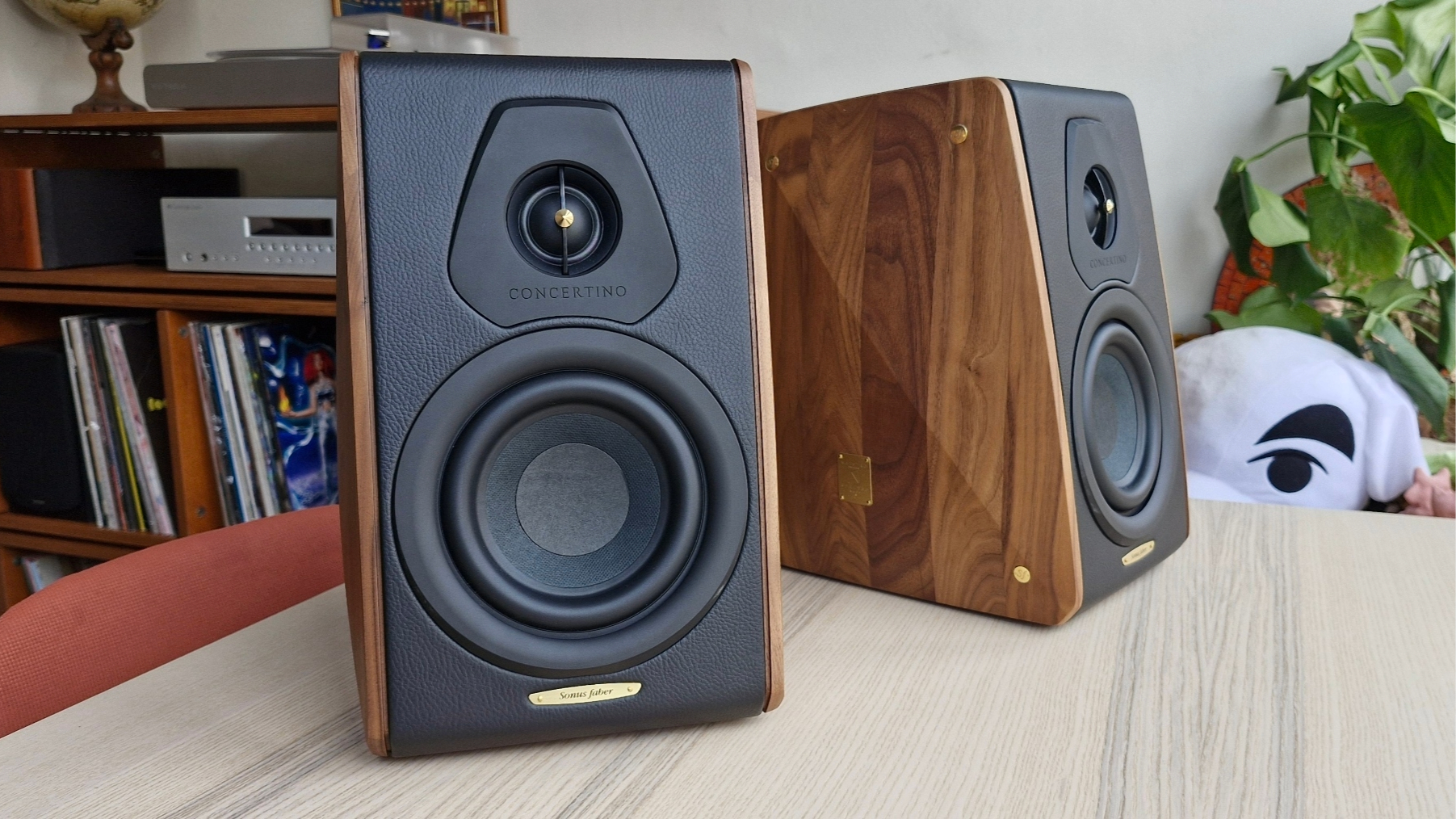
Sonus Faber Concertino G4 review: Price & release date
- Released September, 2024
- Priced $5,000 / £4,625 / AU$9,495
The Sonus Faber Concertino G4 are something of a celebration for the Italian brand – specifically, an anniversary. It’s been 30 years since the first Concertinos made it to listening rooms around the world, and Sonus Faber has deigned to mark the occasion with this special revisit to its classic design.
The first 300 pairs of the Concertino G4 are numbered via a unique brass plate on the left cheek, and sold as the Concertino G4 Maestro Edition; the pair reviewed here is number 29. The occasion, the numbering of the first out of the gate, and the brand from which they hail are all overt clues as to the lofty space these audiophile bookshelfs aim to occupy on the market. The other is the price – $5,000 / £4,625 / AU$9,495 per pair, with purpose-designed iron stands coming in at an extra $1,500 / £1,375/ AU$2,875 (approx.).
These are by no means the most expensive speakers you’ll see from Sonus Faber – indeed, they actually sit quite comfortably at the cheaper end of the brand’s (dauntingly broad) price bracket – but they are nonetheless considerably pricy objects d’art. How do you think they hold up?
Sign up for breaking news, reviews, opinion, top tech deals, and more.
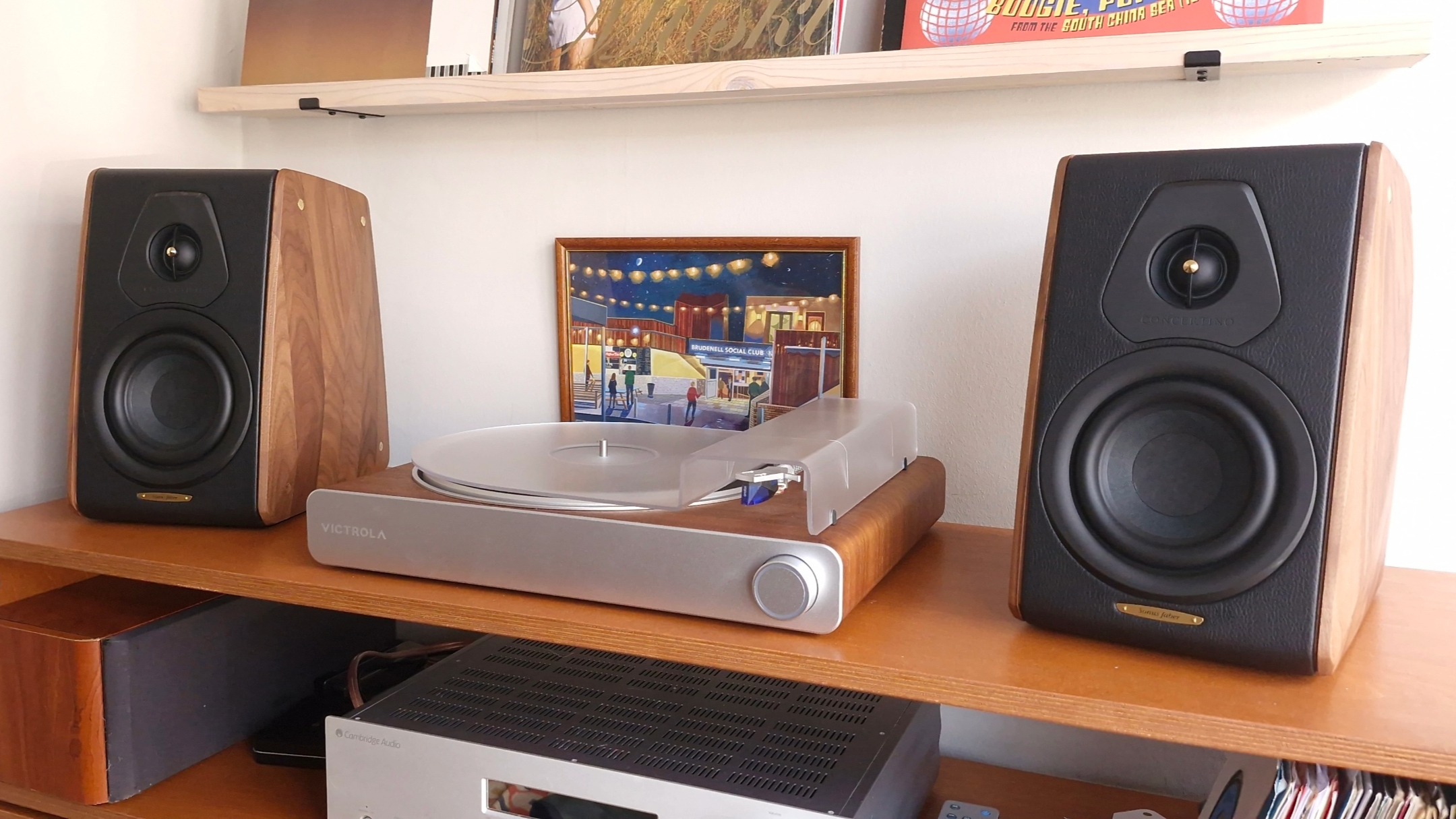
Sonus Faber Concertino G4 review: Specs
Type | Bookshelf |
Active or passive? | Passive |
Bi-wirable? | Yes |
Woofer | 5-inch paper pulp |
Tweeter | 1-inch silk dome |
Impedance | 4 ohms |
Dimensions | 314mm x 214mm x 297 mm |
Sonus Faber Concertino G4 review: Features
- Passive, bi-wirable two-way speakers
- Unique cork damping
- Look at ‘em!
The Sonus Faber Concertino G4 are a pair of passive two-way bookshelf speakers, but also probably the most beautiful pair of passive two-way bookshelf speakers I did ever see. I’ll be breaking down the impeccable aesthetic design of these bookshelfs a little later, but for now – quelle finesse!
Being a passive set of hi-fi speakers, the Concertino G4 are fundamentally uncomplicated and untroubled by the shoehorning-in of needless techy fripperies. However, there are some very nifty goings-on within, that make for a sound as phenomenal as the look. More specifically, the Concertino G4 utilize some precision-modeled cork damping material inside, which does a remarkable job of reducing internal resonances (and, I like to think, contributes a certain ‘springiness’ to the resulting sound of these excellent speakers).
This cork damping is paired, for the first time in Sonus Faber’s history, with a mid-woofer – a 5-inch paper-pulp, long-throw mid-woofer that goes some way to defining the brand’s sonic signature. Couple this with a 1-inch silk-dome tweeter, and you have a stunningly broad, stunningly rich set of living room listeners.
The speakers are, of course, bi-wirable; what else would you expect from a two-way speaker at this price? This writer doesn’t subscribe to the idea that running a bi-wired speaker system results in any tangible sonic improvements whatsoever, but bi-amping is a very different thing entirely – and something the Concertino G4 promise to benefit from all the more.
In the box, you’ll find the speakers, some optional magnetically attachable grille cloth covers, and, if you’re lucky enough to get a double-digit Maestro Edition, one of 100 hand-printed artworks – a copy of an etching, illustrating the Concertino G4’s unique internal damping, delivered in an embossed manila envelope. As far as ‘box candy’ is concerned, this is an excellent little gift, especially for the monumental shame that such downright cool designs are permanently, necessarily hidden from view.
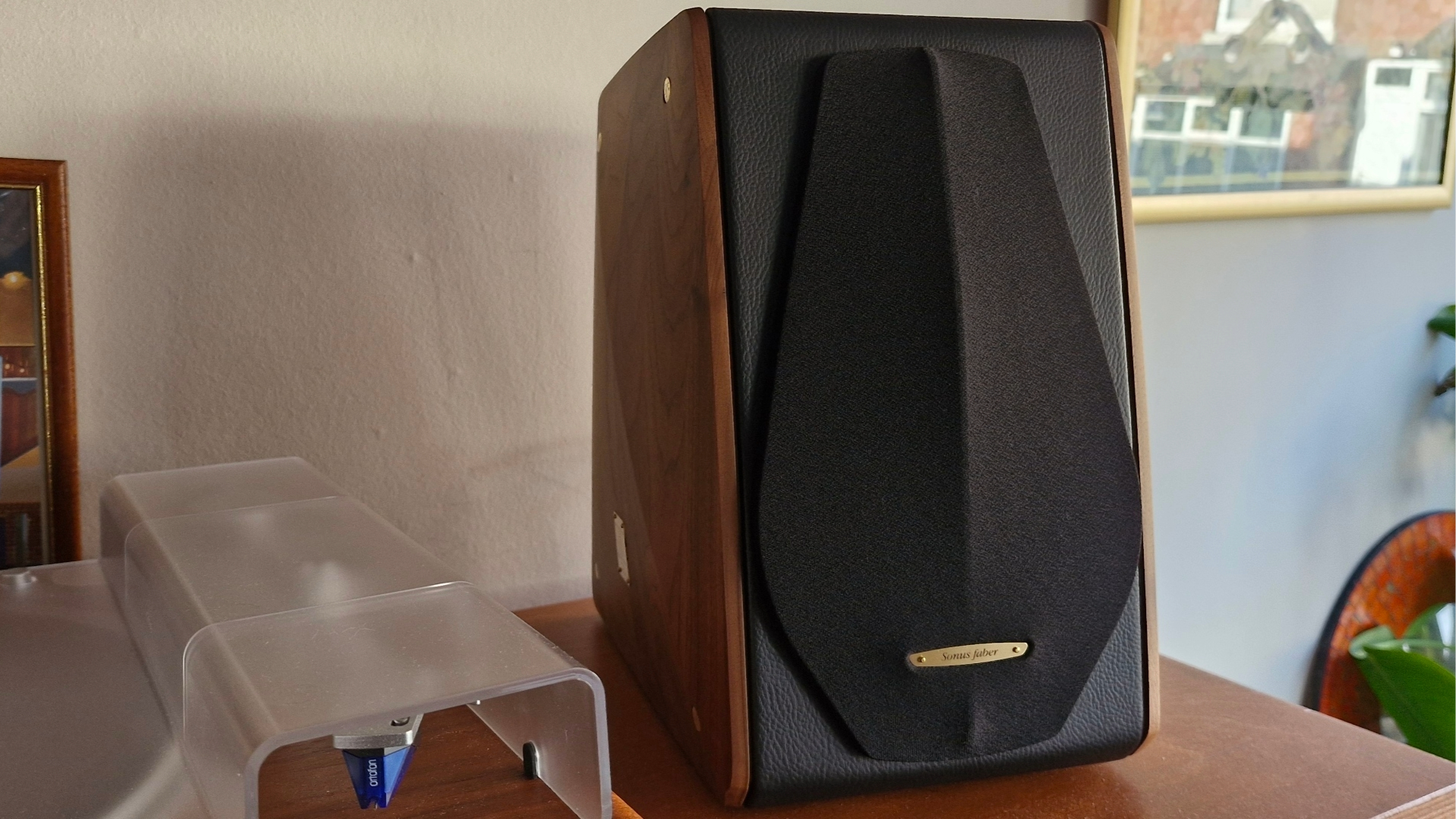
- Features score: 4.5/5
Sonus Faber Concertino G4 review: Sound quality
- Exceptional dimensionality
- Sonorous low-end
- Generous, airy high-end
Holy hell.
Being a writer of variable income (that is, varying somewhere between 'ramen noodles every night' and 'slightly posher ramen noodles every night'), I tend to champion the cheaper stuff over anything. Particularly so when returns diminish starkly after a certain price cut-off, and especially where it’s obvious that a premium brand is cashing in on its perceived pedigree as opposed to offering anything of serious value.
As such, it’s rare for me to recognize anything asking upwards of $2000 as 'worth it'. But the Concertino G4 are exceedingly hard to turn down, simply for the rapturous quality of sound they dare to bring into my humble living room.
I use ‘three-dimensional’ a lot as a term when describing the structure and texture of a given device’s auditory performance, and am forced to again here – but in full acknowledgement that this is about as three-dimensional as any bookshelfs can be. The platonic ideal. The dragon I’ll be chasing for decades to come.
Rich(ard) Dawson’s End of the Middle is a record rich (geddit?) in raw percussive instrumentation, blooming low-tuned guitars and alternately plain-spoken/high-falsetto’d art-folk tales of the unexpected. Through the Concertino G4s, Dawson’s heartbreaking windows into the banal (played from a 12-inch on my Victrola Stream Sapphire) are rendered with stunning richness and clarity.
Aptly for the Sonus Faber name, these are sonorous speakers. The low-end is unbelievably rich and structured; it’s rare to feel like you can reach behind the bass strings and grasp the thick air in their wake. Dawson’s voice is rich [that's enough now – Ed.], complex, and fully present – his fricatives feel as if formed in the room.
High-end information is rendered generously. There’s a sense that all higher elements sit plushly within a cushion of air, presenting themselves forth for scrutiny without force or strain – the same force and strain that, in my self-invented mythos of sound, causes tinniness, cloy or otherwise intolerable screech from lesser sources.
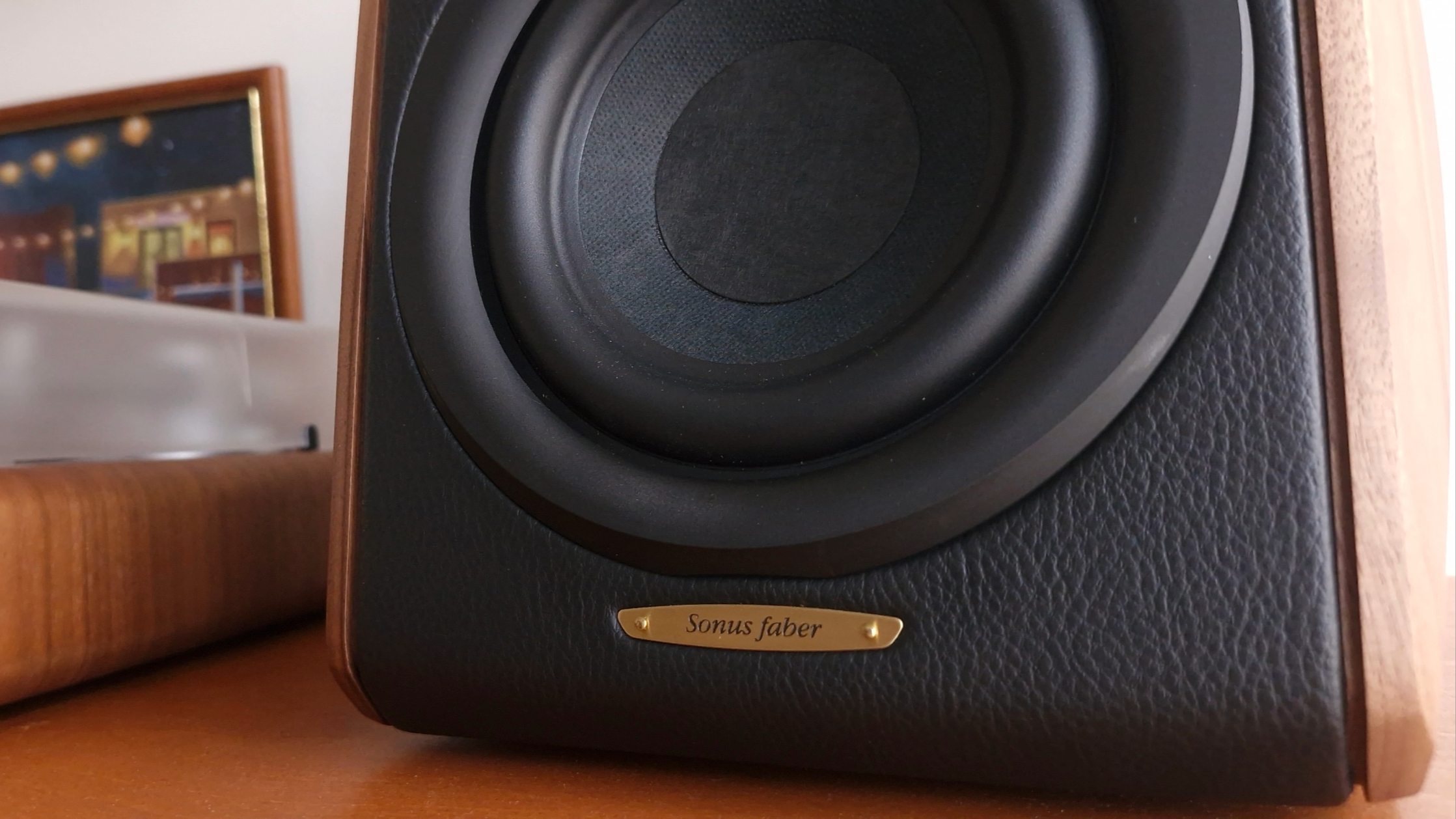
The balance of sound is hugely directional. If you, like me, place these facing across a room as opposed to down it, you’re likely to find patches of especial untamed bass-i-ness. Unsurprisingly enough, if you situate yourself where Sonus Faber’s manual actually instructs you to – that is, dead in front, with the speakers facing you, as one point of an audiophile equilateral triangle – the fruits of the Concertinos’ labor make the sense they’re supposed to make.
Dirty Projectors’ Swing Lo Magellan, also listened to on vinyl, is every bit as immediate as your mind’s ear interprets it. It might be a bit dross to fall on the word ‘musical’ to describe the Concertino G4 here, but here we go nonetheless – the subby kicks of opener Offspring Are Blank are discrete, weighted and musical, a far cry from the placeless wub lesser speakers would offer up as alternative.
As Offspring…’s pre-chorus opens out with twanging guitars, there’s a spring in the step – a delightful bounce emphasized by the rubbery drums and densely sponged short-scale bass of ensuing track About To Die. Percussion throughout the album is supple and giving despite its forefront presence, and David Longstreth’s dry, dead-center vocals are a floaty, reedy delight. My album favourite, The Socialites, has a weight and focus I’ve not heard elsewhere. It's a unique joy.
Speaking of which, the Concertino G4 has no issue bringing that same weight and focus to famously less-focused records, like My Bloody Valentine’s Loveless. Kevin Shields’ stacked soundscapes throb and thrum with excitable energy throughout, while the dead, motorik drums at the center of When You Sleep punch out from behind as if pummeled by a hammer. Side B loud-lullaby Sometimes is a glorious bath of multi-tracked guitars and rabbit-heartbeat kicks, distinct in its indistinctness and clear in its complete lack of conventional clarity. A beautiful paradox delivered through these speakers.
The word I keep returning to with these speakers is ‘generous’. There’s space in and around everything tackled, from distant roomy drums to attention-begging upfront vocals – space enough you genuinely feel as if you could cup each element in your hands, or awkwardly reach around them to grab something. Aside from their clear preference for head-on listening (which is, assuredly, of necessity and by design), these speakers are functionally faultless.
- Sound quality score: 5/5
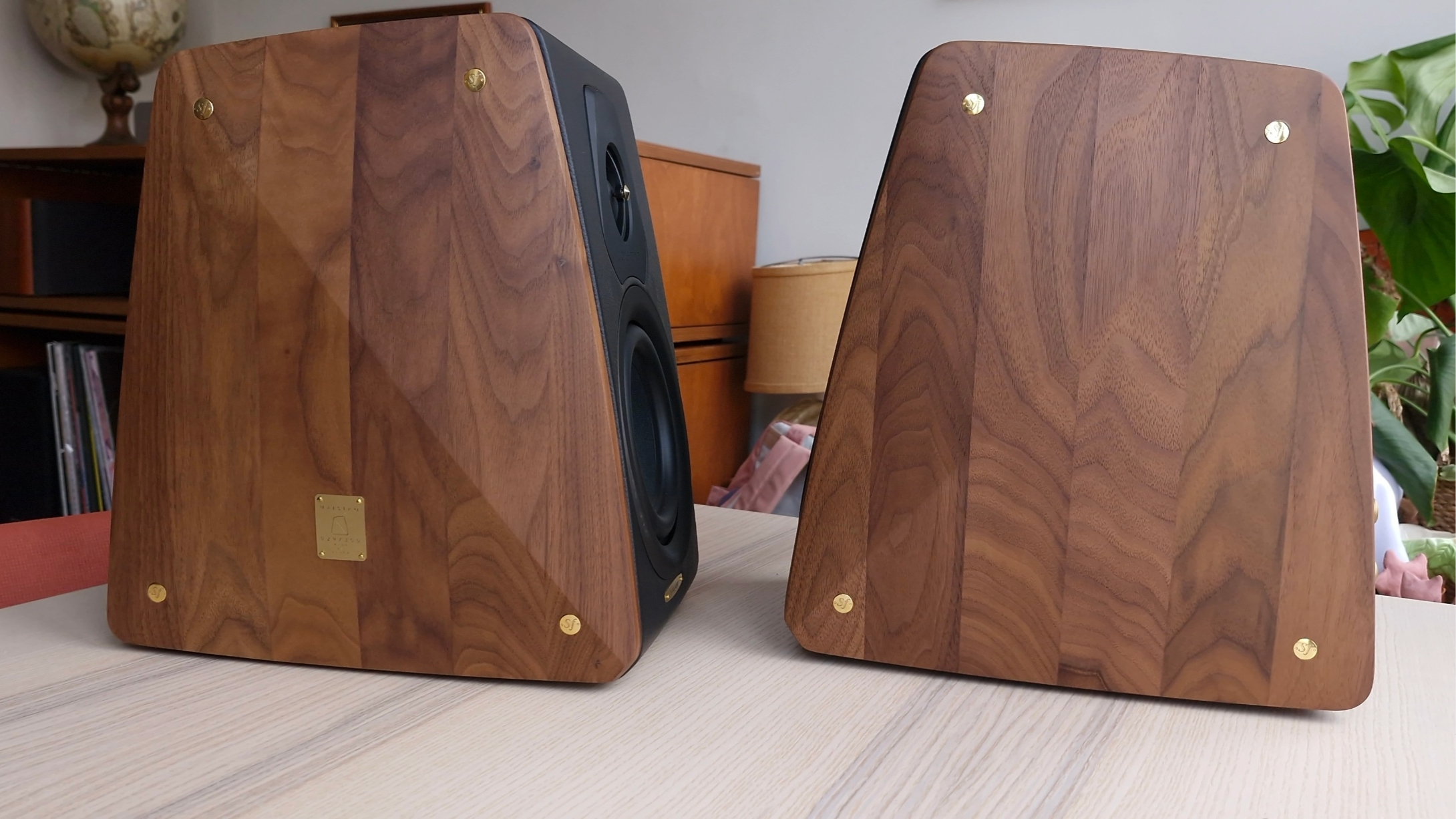
Sonus Faber Concertino G4 review: Design
- Executive walnut and brass build
- Delicious vegan leather cladding
- Nifty magnetically attachable clothe grille covers
Design-wise, it’s hard to know where to start with the Concertino G4s because of Sonus Faber’s trademark meticulousness. Each speaker is a work of art, exuding craftsmanship from every angle. They benefit from beautifully shaped walnut cheeks, with an outward crease that runs from bottom to top, front to rear, and bisect the trapezoidal shape of the whole thing in a very pleasing manner.
New here is the involvement of Ohoskin, an Italian manufacturer of high-quality leather alternatives. This bio-based leather material (made from orange and cactus byproducts) is eco-conscious, sure, but also a stunning ‘pleather’ that clads the top and front of the chassis. It certainly could’ve fooled me.
Between this sleek black not-actually-leather and the solid walnut cheeks, these are a distinctly executive set of audiophile speakers, enhanced further by the mirror-polished brass that forms its front logo panels, rear terminal plates and side-mounted issue number placards. Even the studs holding those walnut cheeks in place are highly reflective, monogrammed indications of attention to detail.
That same attention to detail gifts us sleekness elsewhere. Sonus Faber supplies you with a pair of lightweight cloth grille covers, which you may optionally attach to the front of the Concertino G4 by way of some concealed magnets beneath the pleather.
Now, I think these speakers look far better in their uncovered glory, both for generally preferring uncovered hi-fi speakers and for having my own aesthetic misgivings around the covers' design. Still, the option is a nice one to have, and well-executed besides – from the completely invisible magnets to the soft felt material covering the ‘feet’ on the covers themselves.
- Design score: 5/5
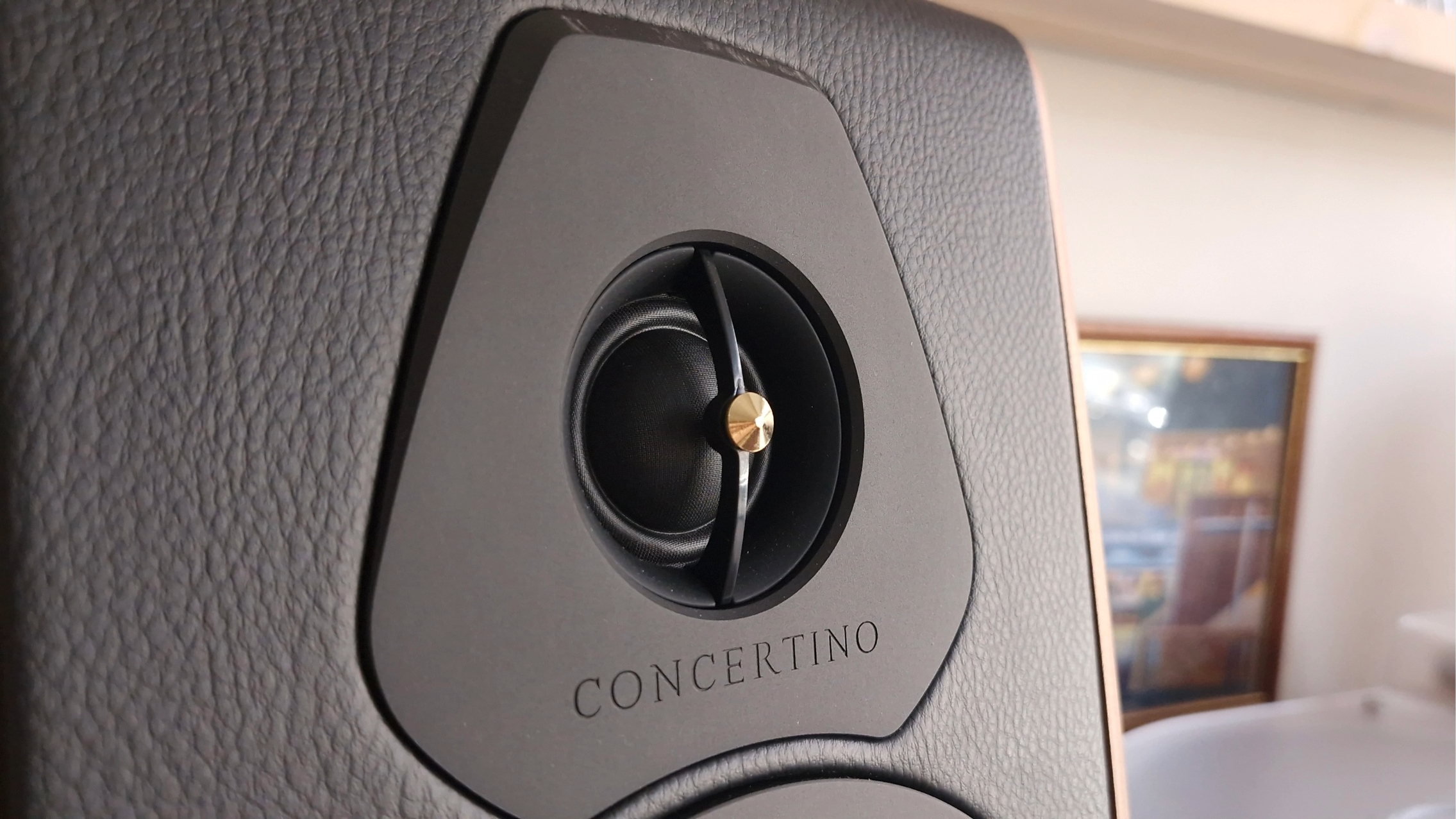
Sonus Faber Concertino G4 review: Value
- Commands a considerable price
- But represents more than just ‘good sound’
- Clearly made with skill, reverence and love
When buying the Sonus Faber Concertino G4, you’re actually buying at least two things, not one. Yes, one of them is an excellent-sounding pair of bookshelf speakers, but you’re also buying an immaculately designed, reverently constructed pair of artworks for your living space. On top of that, if you buy the Maestro Edition, you’re also buying a secret third thing – a limited-edition set, made all the more valuable for its combination of rarity and pedigree. It is with this in mind that I suggest, humbly, that value is difficult to ascribe to this set of speakers.
I’ve heard dozens upon dozens of bookshelf speakers below £1,000 – and even owned a fair few second-hand speakers bought for below £100 – that display similarly remarkable attention to detail in the audio realm, even if their chassis leave a little to be desired. Yet all fall short, however marginally, of the dimensionality on display here. Buying the Concertino G4 for performance alone could be justifiable, yes, but only if you’re willing to throw an extra £3,500 at the extra 5-10% that elevates these speakers above their upper mid-range contemporaries.
Don’t get me wrong, I love the Concertino G4s. It’s a rare pair of speakers that can so convincingly render voices and instruments in discrete three-dimensional space, and nothing short of magic to hear the care with which such sound sources are treated. But you can find this for less. What you can’t is the Italian-made, executive-saloon suavity of the Concertino’s form, or the combination of this hand-built reverence with such deferent approaches to audiophilia.
So, while I might not be currently tempted to sell my belongings in favor of owning the Sonus Faber Concertino G4, I do know that, with the right capital and in the right atmospheric conditions, I’d snap them up in a heartbeat. Not just for their impeccable sound, but for the space they command, and for what that command represents.
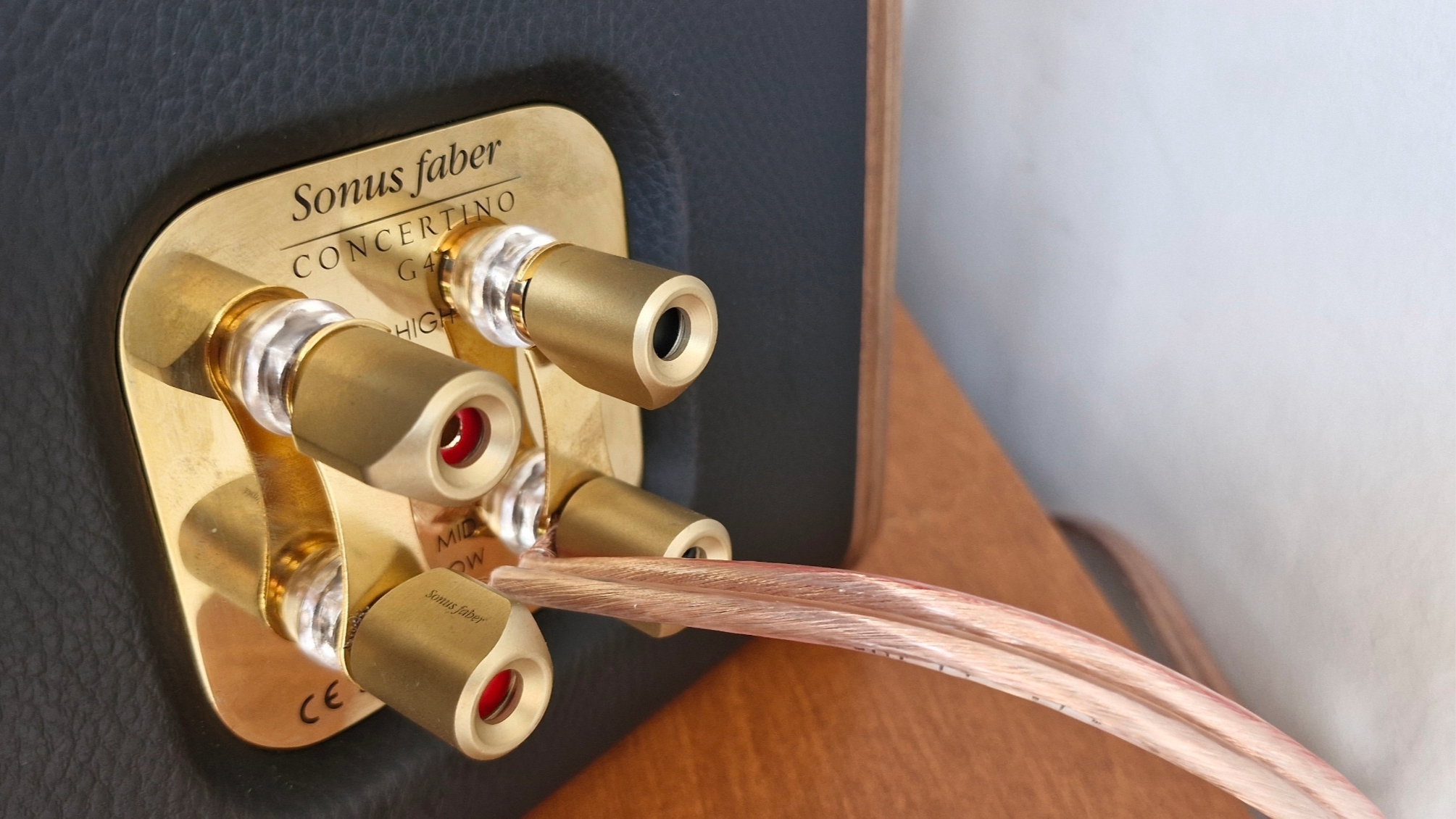
- Value score: 4.5/5
Sonus Faber Concertino G4 review: scorecard
| Row 0 - Cell 0 | Comment | Rating |
Features | Passive, bi-wirable bookshelf speakers; smart internal cork damping. | 4.5/5 |
Sound quality | Massive depth, clarity and three-dimensionality; careful handling of high-end, weighty low-end. | 5/5 |
Design | A masterclass in executive chic. Cloth grille covers aren’t to everyone's taste. | 5/5 |
Value | Pricy, but it buys you a work of practical art, made with reverence. | 4.5/5 |
Should you buy the Sonus Faber Concertino G4?
Buy them if...
You have the cash
The price point is a lot to ask from most people, even if it’s far closer to the floor than the ceiling when it comes to the cost of audiophile-grade hi-fi equipment. That said, these walk the walk – and provide more than sound for the money.
You have a dedicated listening spot
The Sonus Faber Concertino G4 are designed to be listened head-on, like studio monitor speakers. These should be enjoyed as such, then – in a room where they straddle your hi-fi and point directly at your head.
Don't buy them if...
You want a daily driver set of bookshelfs
Sure, the Concertino G4 will serve you marvellously well whatever you deign to throw at them, but buying them for watching Countdown and listening to BBC Radio 4 would be a bit like ordering a Michelin Guide dish on Uber Eats. And scarfing it down while watching Countdown or listening to BBC Radio 4.
You don’t have a dedicated hi-fi spot
You don’t need telling that these speakers want to see the output from an integrated amplifier or broader hi-fi system. You might, though, need telling that these speakers demand their own dedicated space and placement to sound their best.
Also consider
| Row 0 - Cell 0 | Sonus Faber Concertino G4 | Monitor Audio Studio 89 | Sonus Faber Lumina II |
Type | Bookshelf | Bookshelf | Bookshelf |
Active or passive? | Passive | Passive | Passive |
Bi-wirable? | Yes | No | Yes |
Woofer | 5-inch paper pulp | x2 4.5-inch RDT III | 150mm paper pulp |
Tweeter | 1-inch silk dome | x1 MPD III | 29mm silk diaphragm |
Impedance | 4 ohms | 6 ohms | 4ohms |
Dimensions | 314 x 214 x 297 mm | 340 x 157 x 361 mm | 304 x 180 x 263mm |
Monitor Audio Studio 89
Another set of passive bookshelf speakers, they incorporate two RDT III mid/bass drivers and a sandwiched MPD III tweeter, arranged vertically for wider sound dispersion.
See our full Monitor Audio Studio 89 review
Sonus Faber Lumina II
If you want that same Sonus Faber experience without having to worry about a potential remortgage, you can achieve just that with these excellent, ‘budget’ offerings from the Italian artisans. There are shortcomings (including a leather finish that may offend), but does a great job of bringing audiophile quality down a price peg.
See our full Sonus Faber Lumina II review
How I tested the Sonus Faber Concertino G4
- Tested for four weeks
- Used in my living room, as my primary listening speakers
- Tested using a Victrola Stream Sapphire and Cambridge Audio receiver
As someone with considerable personal and professional investment both in the enjoyment of music and in its production, I have unique experience on both sides of the equation. I engage with speakers of various types as a matter of course each day, from flat-response studio monitor speakers to gorgeous, flattering hi-fi numbers like these.
For four glorious weeks, the Sonus Faber Concertino G4 speakers were my primary listening speakers in my living room. I wired them into my Cambridge Audio Azur 540r receiver, which received the sound of my vinyl record collection via a Victrola Stream Sapphire turntable (outfitted with an Ortofon 2M Blue cartridge).
First reviewed: July 2025
Read more about how we test at TechRadar

James Grimshaw is a freelance writer and music obsessive with over a decade in music, audio and tech writing. They’ve lent their audio-tech opinions (amongst others) to the likes of Musicradar, Louder, Guitar.com and the London Evening Standard – before which, they interviewed indie glitterati for online music publications a-many. When they aren’t blasting esoteric music around the house, they’re playing out with esoteric artists in DIY spaces across the country; James will evangelise to you about obscure late-2000s records until the sun comes up.
You must confirm your public display name before commenting
Please logout and then login again, you will then be prompted to enter your display name.
